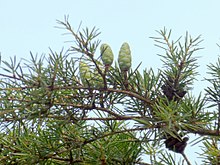| Nothotsuga Temporal range: Eocene–Recent PreꞒ Ꞓ O S D C P T J K Pg N | |
|---|---|

| |
| Nothotsuga longibracteata | |
| Conservation status | |
 Near Threatened (IUCN 3.1) | |
| Scientific classification | |
| Kingdom: | Plantae |
| Clade: | Tracheophytes |
| Clade: | Gymnospermae |
| Division: | Pinophyta |
| Class: | Pinopsida |
| Order: | Pinales |
| Family: | Pinaceae |
| Subfamily: | Abietoideae |
| Genus: | Nothotsuga Hu ex C.N.Page |
| Species: | N. longibracteata |
| Binomial name | |
| Nothotsuga longibracteata (W.C.Cheng) Hu ex C.N.Page | |
| Synonyms | |
Nothotsuga is a genus of coniferous trees in the family Pinaceae endemic to China. Nothotsuga contains only one living species, Nothotsuga longibracteata, commonly known as the bristlecone hemlock or chang bao tie shan (长苞铁杉), which is found in southeastern China, in southern Fujian, northern Guangdong, northeast Guangxi, northeast Guizhou, and southwest Hunan.
The genus was more diverse in the past, with its earliest fossils being known from Europe during the late Eocene epoch, with the genus being present in Europe as recently as the Pliocene. The oldest fossils near its current distribution dating to the Miocene epoch.
Description
N. longibracteata is an evergreen tree reaching 30 m (100 ft) tall. The leaves are flat, needle-like, 1.2–4 cm (0.5–1.6 in) long and 1–2 mm (0.04–0.08 in) broad, very similar to those of Tsuga. The cones are very similar to those of Keteleeria, but smaller, 2.5–5 cm (1–2 in) long, erect, and mature in about 6–8 months after pollination.
Taxonomy
In many respects, Nothotsuga is intermediate between the genera Keteleeria and Tsuga. It was discovered in 1932, and at first treated as Tsuga longibracteata, being classified in its own genus in 1989 when new research indicated how distinct it is from other species of Tsuga - by the larger, erect cones with exserted bracts, and (like Keteleeria) male cones in umbels, and from Keteleeria by the shorter leaves and smaller cones.
Conservation
It is a very rare tree listed as a near-threatened species by the International Union for Conservation of Nature due to historical deforestation, though it is now protected.
References
- ^ Farjon, A.; Christian, T.; Zhang, D. (2013). "Nothotsuga longibracteata". IUCN Red List of Threatened Species. 2013: e.T34162A2848919. doi:10.2305/IUCN.UK.2013-1.RLTS.T34162A2848919.en. Retrieved 2 October 2024.
- "Nothotsuga longibracteata (W.C.Cheng) Hu ex C.N.Page". World Flora Online. Retrieved 2 October 2024.
- Wu, Zheng-yi; Raven, Peter H., eds. (1999). Flora of China: Cycadaceae through Fagaceae. Flora of China. Vol. 4. Science Press and Missouri Botanical Garden Press. pp. 39–40. ISBN 0915279703. OCLC 223628675.
- Dong, Junling; Li, Zhe; Gao, Jingxin; Wang, Qian; Sun, Bainian (2022-12-26). "A New Fossil Species of Nothotsuga from the Mula Basin, Litang County, Sichuan Province and Its Paleoclimate and Paleoecology Significance". Biology. 12 (1): 46. doi:10.3390/biology12010046. ISSN 2079-7737. PMC 9855038. PMID 36671738.
Further reading
- Jin-xing, Lin (1995). "Wood and Bark Anatomy of Nothotsuga (Pinaceae)". Annals of the Missouri Botanical Garden. 82 (4): 603–609. doi:10.2307/2399841. JSTOR 2399841.
External links
| Classification of Archaeplastida or Plantae s.l. | |||||||||||||||||||||||||||||||||||||||||||||||||||||||||
|---|---|---|---|---|---|---|---|---|---|---|---|---|---|---|---|---|---|---|---|---|---|---|---|---|---|---|---|---|---|---|---|---|---|---|---|---|---|---|---|---|---|---|---|---|---|---|---|---|---|---|---|---|---|---|---|---|---|
| |||||||||||||||||||||||||||||||||||||||||||||||||||||||||
| |||||||||||||||||||||||||||||||||||||||||||||||||||||||||
| Classification of Acrogymnospermae (living Gymnosperms) | |||||||||||||||||||||||||||||||||||||||||||||||||||||||||||||||||||||||||||
|---|---|---|---|---|---|---|---|---|---|---|---|---|---|---|---|---|---|---|---|---|---|---|---|---|---|---|---|---|---|---|---|---|---|---|---|---|---|---|---|---|---|---|---|---|---|---|---|---|---|---|---|---|---|---|---|---|---|---|---|---|---|---|---|---|---|---|---|---|---|---|---|---|---|---|---|
| |||||||||||||||||||||||||||||||||||||||||||||||||||||||||||||||||||||||||||
| Taxon identifiers | |
|---|---|
| Nothotsuga | |
| Nothotsuga longibracteata |
|